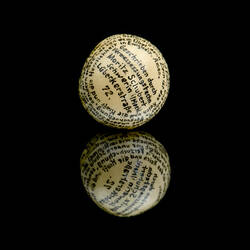Further Media
Sebastian Köpcke (*1967), Volker Weinhold (*1962) | Photographers
The mother of Moritz, who was born in 1894 in Bad Warmbrunn in Lower Silesia and raised as a Christian, recited the prayers “Müde bin ich, geh zur Ruh...” (I’m tired now and go to rest) and the Lord’s Prayer every evening when he was a child. He attended the Catholic primary school and also learned carving, modelling and drawing as a 12- to 15-year-old in the woodcarving school, also at the initiative of his mother. As a trained surveying technician, Schubert moved to Mecklenburg in 1919, where he worked with the state land surveying office and as an engineer in the transport ministry in Schwerin, among other employment.
This pea with a handwritten prayer is an impressive document of religiously motivated folk art. Moritz Schubert gave this object to the museum in the autumn of 1989. A true windfall for the museum was also the letter that the creator sent with the object. This is because not only the pea itself is extraordinary; the circumstances surrounding the origins of this artwork are also special.
In the 1930s, Moritz Schubert worked in the state land surveying office in Schwerin and, in addition to his actual work, was involved in a friendly competition revolving around writing on the smallest things. Spurred on by a snide comment from his supervisor, Schubert was then inspired to a tour de force. Looking back, he told the story of the origins of the pea in his letter to the museum director as follows:
A meeting took place between Councillor Timm and Dr Knebusch on 4 January 1933. I was called for, and when I greeted Dr Knebusch, he said: “Oh, you must be the man who wrote the Lord’s Prayer on a pea.” My response was “No, I’m not, but I could also do that.” Mr Timm then answered, “I don’t believe you can do that.” [...] On the evening of the same day, I asked my wife for a small pea. I took my trouser clip for cycling (these used to still have a snap lock for holding them tight). The pea fit in it and it could be adjusted in all directions. Then I took one of my very sharp English drawing pens and diluted the Chinese ink with some spiritus in a little flask. From there I proceeded easily. The prayer on the pea was finished in 1 ½ hours. I used a thread counter for textiles as a magnifying glass.
The next day I showed the pea to my colleague, and he made sure it became known, so I didn’t even have to show the Councillor the pea at all. My son then absolutely wanted to show the pea to his secondary-school teacher. He claimed that it wasn’t real, that it must have been done photographically. It then happened that his fellow pupils definitely wanted to see the pea, and it suffered from being handled a great deal and falling.
[...] My Catholic faith came into action and I learned that my dear sister [...] had converted to Protestantism; I then also did that, also out of respect for my Protestant family. The spiritual conversion within the Christian faith now stimulated me to write on a pea a second time. This is in fact 1 mm larger, but the writing is more legible.
The pea was stored in the depot for around 25 years and was not shown to the public. Then it became part of the permanent exhibition of the museum, where it is, however, often overlooked due to its measurements. And even when guests discover it, it is nonetheless almost impossible to decode the Lord’s Prayer claimed to be there in the object description with the naked eye.
Moritz Schubert (1894-after 1989) | producer
MATERIAL & TECHNIQUE
pea, handwritten
DIMENSIONS
H 0.85 x D 0.95 cm
MUSEUM
Museum für Sächsische Volkskunst
DATING
Schwerin, 1937
INVENTORY NUMBER
E 2142
